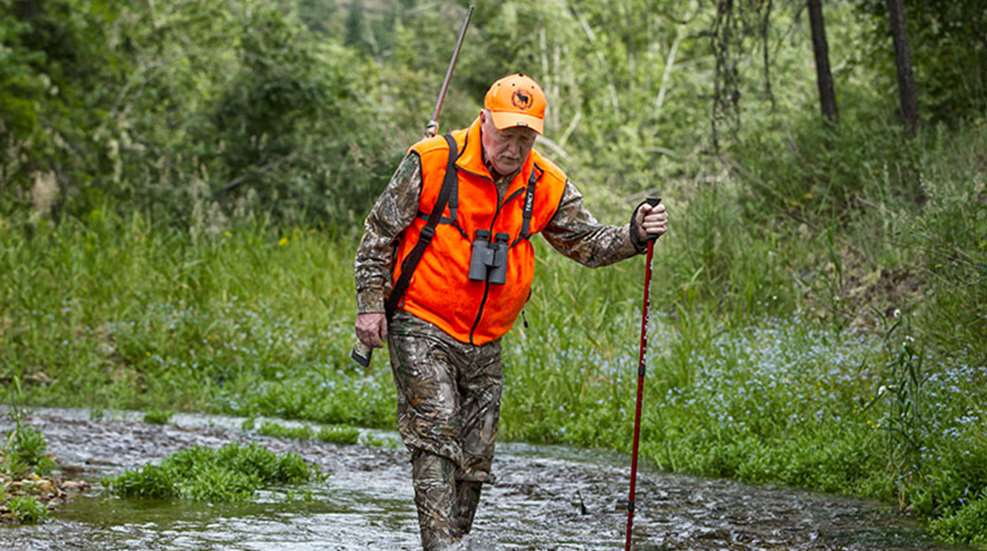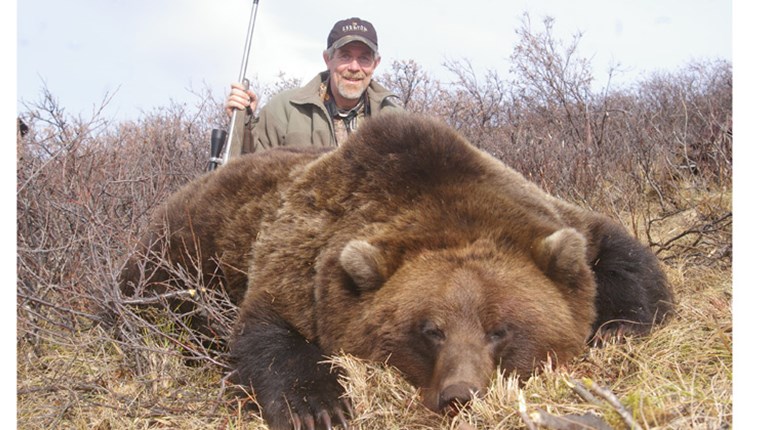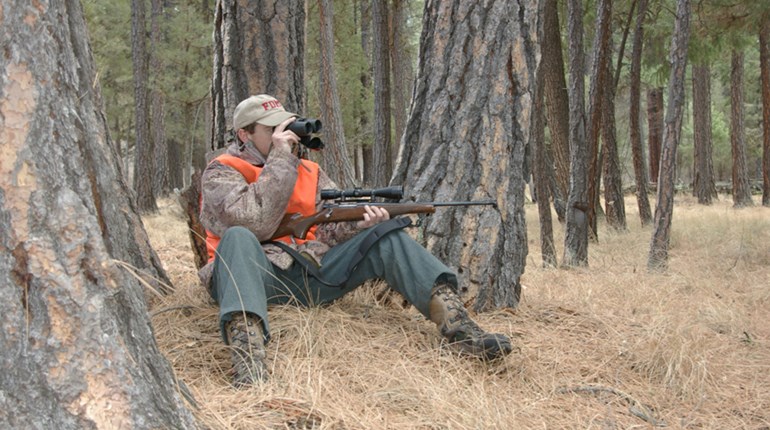
'Twas the day after Christmas
And all through the hills
Some deer were still rutting …
It gave me the chills …
Sorry, I never was much of a poet, but words to that effect were bouncing around in what’s left of my mind as I plodded uphill in a sizable pasture in central Virginia. Only about a week remained in last year’s deer season, and I had yet to lay a whitetail down to provide venison for my wife and me in the coming year.
That pleasant chore becomes more of a challenge with each passing season. Back when I was a young’un and still working full time, I would be afield every hour that personal and social demands allowed. When I retired at age 66, my free time was virtually limitless. Rita and I moved to a home atop a knob in rural Rockbridge County (we’d always lived in suburbs of big cities), and I reveled in stalking critters with a compound and then, as physical strength ebbed a bit, a crossbow. Followed, of course, by boomsticks in muzzleloader and then rifle seasons.
The near decade that followed was a time of drinking in the delights of country living—watching the weather form and fade from our front porch, picking wild berries, putting up with the local rush hour (four cars at a red light), catching trout and bass in the whitewater streams nearby. I even self-published my first and only book: Fishing for God—and Vice Versa (it has hunting stories, too—you should read it; available at Amazon and Barnes & Noble, or via email at [email protected]).
About halfway through that decade, though, came the replacement of both knees and triple-bypass heart surgery. Thanks to talented surgeons and maybe my lucky Irish heritage, I was told I was “good to go” back into the local (and some distant) woods and waters. The knees suddenly felt like the best part of my old carcass, and my ticker had suffered no permanent damage.
I’d spent the better part of that late-December afternoon parked against a gnarled old hickory that gave me a sort of long-distance drive-in-movie perspective of an open hilltop to the north. Silhouetted up there against the sky was an X-rated wildlife drama as a sizable buck chased a chorus of demure does into and back out of patches of red cedar. They were well out of range, and a house out there beyond the hilltop ruled out a logical approach. The sun was setting when the players went backstage for good.
A few minutes later I began to trudge uphill to the west, where my old Cherokee was parked. About 80 yards from a brushy hedgerow that included a few big trees, I stopped to assess where to cross the barbed wire. At that moment we spotted each other: Standing motionless in the cover, all eight points of his antlers black against the sooty pink sunset, was almost certainly the stud I’d been admiring earlier. I tried the motionless bit, too, but despite my age and experience I’m sure I was more like ground zero at the birth of an earthquake.
It took a full minute anyway to get my M77 Ruger .308 level on the animal. I probably shot too fast, fearing he’d bolt. And yet he remained in place, likely thinking he was safe in that darkening cover. But from my perspective his head, neck and a bit of his upper back were framed beautifully by brush and an overhanging tree branch. Thanking the Big Guy, I drew down again, trying to stay calm. I fired again: Still no movement! What? my mind said to me. Is this a senior moment? Am I creating this critter in my head?
When my eyes opened after the third shot, the mirage was gone. Hoping against hope, I walked slowly to the scene. There he was, his penetrated head propped up on the lowest wire. I raised my hands in thanksgiving and fumbled in the pack for my flashlight and my knife.
I’ll admit that my jubilation that evening included a dollop of relief: I’d taken this animal despite being a certified (and maybe certifiable) codger of 77, despite having skin that in places looks like the ripples a big trout makes in rising to take a mayfly, and despite often calling to mind old saws like “Gettin’ old ain’t for sissies.”
Many of you reading this piece, I suspect, would agree that hunting and the natural world are far more than a pastime: They are a way of life, a challenge/pleasure that defies description. Though it is certainly not a spectator sport, hunting has an uncanny ability to generate and nurture lifelong friendships. I am hugely blessed to have a handful of friends who share my affair with hunting and the outdoors. In dirt-floored cabins, riverside campsites, and unpeopled wild country from Maine to Mexico, Virginia to Montana and Florida to Alberta, we’ve tested ourselves, toasted and roasted each other, laughed until we cried, and come to know the best and the worst about each other.
As we all age and get crotchety and treasure our memories, these guys become more important to me than ever before. They are more than friends—they are mirrors of me. I’ve asked a few of them (you may recognize some names here) to “own up” about how they are dealing with the rigors of the aging process.
■■■
Jim Zumbo and his long-suffering wife, Madonna, live in a comfortable log home halfway up a 10,000-foot mountain just a few miles from Yellowstone National Park. For many years Jim was the hunting editor for Outdoor Life, and that’s how we came to know one another. I was a staff editor for the magazine back in those years, and managed to wangle a few invites to hunt out of his home. Those experiences—this Easterner’s first exposure to the Rockies—remain among the most vivid and uplifting of my life, even after half a century.
Though he'll never see 74 again, Zumbo still essentially runs at fast forward: After 21 years of trying, he received a special permit to hunt moose in Colorado this fall, and that’s just one of his big-game targets around the Mountain West. He loves to hunt in the snow and cold, and still fishes as much as ever. It takes 20 cords of wood to heat his house, and guess who wields the ax?
In a phone conversation a couple weeks before this writing, Jim said he’d had a heart attack two years ago just after getting home from a mountain goat hunt in Montana. He lucked out—as I did with my heart problems—but some “mind residue” remains. He cites an awareness that his balance isn’t as honed as it used to be: He climbs rugged country a bit slower and more carefully, avoids the worst spots and often uses a walking stick to ease pain in his legs. He even fessed up to wielding one of those “picker-upper” rods, using it to grab pine cones for kindling and such.
Jim also told me his “Italian pride” is relaxing a bit these days: Used to be that he wouldn’t let anyone give him a hand at jobs he believed he should take care of—like dragging a big animal to a truck. Today he knows his buds are looking out for him and tends to accept their aid.
■■■
Tim Christie, now 67, and I became immediate friends during our first sojourn together, the Great Canadian Rockies JD Tour in March 2004. (I cannot reveal the meaning of JD in polite company.) Hundreds of miles in his truck in magnificent country took us to creatures ranging from ptarmigan to bighorn sheep and elk, and more than proved his prowess with long-lens cameras. Can you imagine approaching an all-white ptarmigan and photographing it against 3 feet of snow? On snowshoes?
Here is Tim’s take on how to handle the onset of age:
“Hearing loss and eyesight changes tend to affect most of us as we get older. Back when most of us gray-hairs were growing up, almost nobody warned against hearing damage caused by shooting firearms. Now, with 80 percent hearing loss in my left and 40 percent in the right ear, hearing aids are must-wear items for me. (In right-handed gun users, muzzle blast affects the left ear much more than the right.)
“Today I wear earplugs whenever I hunt or sight-in. At the range, that’s no problem. But hunting with plugs handicaps you. This past year I discovered Etymotic GunSport Pro electronic earplugs. They’re soft earbuds with built-in electronics that enhance hearing up to five times. Most importantly, they feature automatic hearing protection, blocking out muzzle blast from rifles, muzzleloaders and pistols. The buds are connected by a string, making them harder to lose afield. Though not as sensitive as my hearing aids, they let me hear and protect what hearing I have left.
“Vision loss is another handicap that comes with age. People in their 40s begin to experience the effects of presbyopia, a natural phenomenon that hardens the eye lens and causes reduced up-close vision such as reading, shooting with a scope and sighting-in guns. A scope’s crosshairs can get blurry because they are too close to the eyes.
“Optician and hunter Joe Cherry helped to design Scope Aid, a lens that works with your individual vision challenges. ‘Scope Aid,’ Cherry says, ‘takes into account your prescription optics, and calculates the distance between the scope lens and your eye, as well as a hunter’s natural shooting position. The result is a powerful lens that enables you to fine-tune your targets just as you did when you had younger, more flexible eyes.’
“And then there are the parts of the body that move you along—knees, hips, shoulders and other joints deteriorate over the years. Last hunting season it was my right knee. This fall I am taking along on three demanding hunts a companion called plantar fasciitis. Your plantar fascia is a strong, ligament-like band of tissue stretching from your heel to the bones in your middle foot. When inflamed, it creates excruciating pain, making hiking or simply walking almost impossible. Thankfully, stretching exercises and massage therapy help tremendously.
“Stability and balance are other victims of age. Years ago Bill McRae, an outstanding wildlife photographer and writer, introduced me to walking sticks. They take pressure off your knees and give added stability in rugged terrain. Today I use collapsible aluminum walking sticks that adjust to various heights and, in a pinch, serve as a rifle rest for shots at game.
“Finally, there is attitude. When the passion and strength of youth wane, it’s tough to keep the fire burning. One suggestion: It is worlds easier to stay in good physical shape than it is to keep trying to catch up each fall. And one alternative: For us older game seekers, a memorable hunt can mean sleeping late, spending time around campfires regaling past hunts, and savoring the comradeship of those in camp."
■■■
Jim Miller is professor emeritus in the Department of Wildlife and Fisheries at Mississippi State University, Starkville, a lifelong member and former president of The Wildlife Society, and has more than 70 years of hunting under his belt. I swear that each April he grows long feathers on his butt, fans them out and talks the truest turkey talk you can possibly imagine. And even the old toms buy it: I’ve been there—I know!
Each spring for almost as long as I’ve known him, Ol’ Miller packs his big truck with good scatterguns and calls and decoys and such, and goes calling on a special cadre of friends he’s made over his career, including 33 years of federal service with the U.S. Fish and Wildlife Service and USDA. The goal? To reduce to possession—for his pals and for himself—one of the most confounding and challenging of this nation’s game targets, the wild turkey.
Thankfully, he invariably includes Virginia in these travels. He and I are about the same age, but I want to tell you … this guy is in terrific shape. One example: I knew it was coming—it’s pitch black and we’re humping up a convoluted mountain in rural Amherst County. I have my shotgun and a small waist pack; he has his gun, a big backpack, and another sack full of decoys and God knows what else. After less than 100 yards I can barely make him out up ahead of me. By the time we get to a confluence of sidehills and sit against trees, I’m envisioning what the Bataan Death March must have been like. His calling that morning got a tom interested, but no shots were fired.
When Jim gets to talking to humans, however, you learn that he is cerebral about hunting: “I treasure everything about it, the planning and prep, the sights and smells, the privilege of observing animal behavior, the thrills of the chase, the cleaning and feasting. It demands physical fitness, personal discipline and a code of ethics. It recharges my batteries, uplifts my perspective about life in general and provides priceless memories.
“To my mind, hunters are heroes. They were the first to call for laws to restore wildlife populations, and they continue to support and defend scientific wildlife management. And they’re passionate about wild things and wild places.”
Now, there’s a spokesman.
As for the rigors of getting up in years, Miller is matter of fact. It’s only been a year or two since he accepted the need for hearing aids. He says his new Audibel A4s, Model 312RIC, are a great help. And since he spends a good deal of hunting time in the Southern turkey and deer woods and has had a bout with tick fever, he religiously wears a set of Cabela’s Bug Skinz underwear.
■■■
Back in the Dark Ages of the 1960s and 70s, Vin Sparano and I toiled together in midtown Manhattan on the staff of Outdoor Life. I made it to managing editor, and he was named editor in chief, holding that title for five years and then “winding down” with the rubric of editor emeritus. Now he and I are full-fledged geezers trying to hold onto the title of hunter.
Vin doesn’t hunt much anymore, but he has a wonderful way of keeping his hand in it and his mind active by writing superb outdoor books—in the process informing and stimulating younger people interested in the natural world and its pursuits. Among these well illustrated creations are The Complete Outdoors Encyclopedia (four editions), Complete Guide to Camping and Wilderness Survival and his latest, Complete Guide to Fresh and Saltwater Fishing, published in 2015.
Here are a few of ol’ Sparano’s musings about the pleasures of hunting:
“Know what I miss most about all those hunting trips? I miss the adrenaline and energy that I had climbing in and out of Montana basins looking for elk. I miss the rush of facing a hulking Cape buffalo, slogging in knee-deep bogs hunting caribou and crawling in icy rain to get a shot at a Wyoming antelope. I was indestructible. I could walk, climb and hunt forever. But, alas, those days are long gone. A buddy keeps telling me, ‘Don’t cry because it’s over, smile because it happened.’ I know he’s right, but it’s still a bitter pill.
“Cheer up, friend. I have no regrets for the life I’ve been blessed with. Decades ago I got into the habit of picking up a stone or rock on every hunt. When I got home, I marked it with the place and date of my hunt. It may sound foolish, but I have shelves in my den with dozens of stones. I’ve built a treasure chest of memories, and I can visit them anytime I want. You can even take the liberty of embellishing some of those hunts that turned into nightmares.
“But don’t feel sorry for me just yet. I still hunt and fish, but now I’m a stump sitter. I never liked treestands anyway. Maybe I can’t pull a bow anymore, but my .30-06 goes faster than an arrow. And when it gets too cold, I make no apologies for heading back to the cabin at 9 a.m. for a hot bowl of oatmeal with a brandy chaser. In my deer camp, the young guys chop firewood! That’s a wonderful bonus for getting old!”
■■■
One last point: At the start of this piece, I told about taking a heavy-bodied 8-point at the end of the 2015 season. I gave that animal to Virginia’s Hunters for the Hungry—another reason to keep on keeping on. And on the next-to-last day of hunting in early January I dropped a sleek doe, ensuring that our venison artichoke meals will continue well into 2016. Life is good—even given the challenges we “mature” hunters must deal with.




































